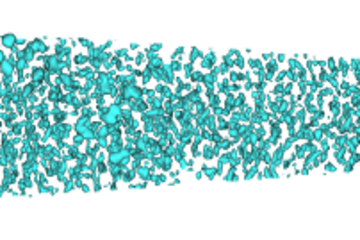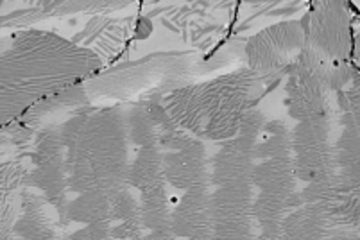All genres
1.
Journal Article
Effect of Concentration on the Interfacial and Bulk Structure of Ionic Liquids in Aqueous Solution. Langmuir 34 (8), pp. 2637 - 2646 (2018)
2.
Journal Article
Adhesive barnacle peptides exhibit a steric-driven design rule to enhance adhesion between asymmetric surfaces. Colloids and Surfaces B 152, pp. 42 - 48 (2017)
3.
Journal Article
Unraveling Hydrophobic Interactions at the Molecular Scale Using Force Spectroscopy and Molecular Dynamics Simulations. ACS Nano 11 (3), pp. 2586 - 2597 (2017)
4.
Journal Article
Soft matter interactions at the molecular scale: interaction forces and energies between single hydrophobic model peptides. Physical Chemistry Chemical Physics 19 (6), pp. 4216 - 4221 (2017)
5.
Journal Article
On the origin of the improved ruthenium stability in RuO2 - IrO2 mixed oxides. Journal of the Electrochemical Society 163 (11), pp. F3099 - F3104 (2016)
6.
Journal Article
Molecular Spin Crossover in Slow Motion: Light-Induced Spin-State Transitions in Trigonal Prismatic Iron(II) Complexes. Inorganic Chemistry 55 (11), pp. 5254 - 5265 (2016)
7.
Journal Article
The Effect of Water and Confinement on Self-Assembly of Imidazolium Based Ionic Liquids at Mica Interfaces. Scientific Reports 6, 30058 (2016)
8.
Journal Article
How specific halide adsorption varies hydrophobic interactions. Biointerphases 11 (1), 019007 (2016)
9.
Journal Article
Resolving Non-Specific and Specific Adhesive Interactions of Catechols at Solid/Liquid Interfaces at the Molecular Scale. Angewandte Chemie International Edition in English 55, pp. 9524 - 9528 (2016)
10.
Journal Article
Resolving Non-Specific and Specific Adhesive Interactions of Catechols at Solid/Liquid Interfaces at the Molecular Scale. Angewandte Chemie 128, pp. 9676 - 9680 (2016)
11.
Journal Article
Targeted Tuning of Interactive Forces by Engineering of Molecular Bonds in Series and Parallel Using Peptide-Based Adhesives. Langmuir 31 (40), pp. 11051 - 11057 (2015)
12.
Journal Article
Characterizing the Influence of Water on Charging and Layering at Electrified Ionic-Liquid/Solid Interfaces. Advanced Materials Interfaces 2 (12), 1500159 (2015)
13.
Journal Article
Direct and quantitative AFM measurements of the concentration and temperature dependence of the hydrophobic force law at nanoscopic contacts. Journal of Colloid and Interface Science 446, pp. 244 - 251 (2015)
14.
Journal Article
Klebstoffentwicklung aus dem molekularen Baukasten - Phänomen der Adhäsion entschlüsselt. Adhäsion, pp. 51 - 55 (2015)
15.
Journal Article
Elucidating the structure of solid/electrolyte interfaces - Force probe experiments at hydrophilic, hydrophobic and electrified aqueous as well as ionic liquid|electrode interfaces. Bunsenmagazin 2, pp. 49 - 55 (2015)
16.
Journal Article
Developing a general interaction potential for hydrophobic and hydrophilic interactions. Langmuir 31 (7), pp. 2051 - 2064 (2015)
17.
Journal Article
Spin-state dynamics of a photochromic iron(II) complex and its immobilization on oxide surfaces via phenol anchors. Russian Journal of Coordination Chemistry 68 (17-18), pp. 3099 - 3115 (2015)
18.
Journal Article
Phenomenon of adhesion decoded [Phänomen der Adhäsion entschlüsselt]. Adhäsion Kleben und Dichten (4), pp. 51 - 55 (2015)
19.
Journal Article
Influence of molecular dipole orientations on long-range exponential interaction forces at hydrophobic contacts in aqueous solutions. ACS Nano 8 (10), pp. 10870 - 10877 (2014)
20.
Journal Article
Thiocyanate Anchors for Salt-like Iron(II) Complexes on Au(111): Promises and Caveats. Zeitschrift für Naturforschung B 69b, pp. 1164 - 1180 (2014)











